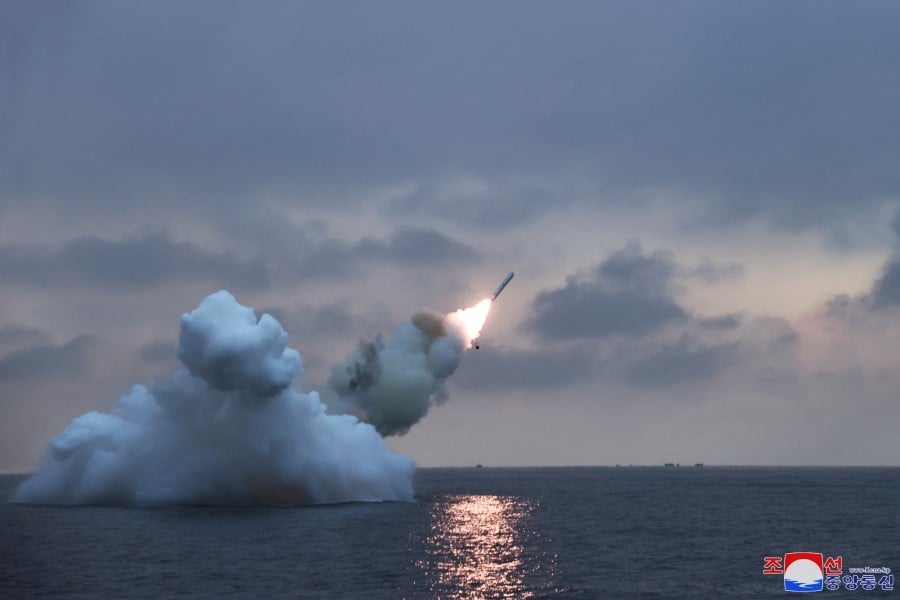
North Korea continued testing its latest cruise missile with firings of its submarine-launched version on Sunday, which state media claims were witnessed by North Korean leader Kim Jong Un.
State-run Korean Central News Agency (KCNA) reported on Monday that on Sunday morning, the Kim, accompanied by the secretaries of the Central Committee of the Workers’ Party of Korea (WPK), North Korea’s navy chief and other leading officials, guided the test-fire of the newly developed submarine-launched cruise missile Pulhwasal-3-31. The two missiles reportedly flew over the Sea of Japan, also known as the East Sea,to hit the island target.
KCNA did not state the location of the firing or the platform used, and released showed the firing point obscured by launch smoke, making it undeterminable as to what was the launch vehicle.
North Korea in September last year launched its first operational tactical nuclear-attack submarine No. 841 Hero Kim Kun Ok, which appears to be a modified Romeo-class submarine capable of carrying and launching ballistic and cruise missiles, though analysis on the submarine’s operational status is divided.
Earlier on Wednesday, North Korea had conducted its first launches of the same cruise missile, launching them from the surface to the sea. The various U.N. resolutions on North Korea only ban ballistic missiles but, despite the fact that cruise missiles are capable of carrying nuclear warheads.
South Korea’s Joint Chiefs of Staff (JSC) only issued a brief statement on Sunday, stating, several cruise missiles were detected near Sinpo and U.S and South Korean intelligence agencies were analysing the even., “The ROK military is closely coordinating with the U.S. side while enhancing surveillance and vigilance, and is monitoring further signs and activities of North Korea,” concluded the statement.
The port city of Sinpo is not only a major North Korean defence industry hub, whose activities also include submarine construction, but also has a major submarine that hosts North Korea’s ballistic-missile armed submarines.
“The test-fire had no impact on the security of a neighboring country and has nothing to do with the regional situation,” stated the KCNA report which also said that Kim expressed great satisfaction with the result. KCNA also reported that the North Korean leader stated the current situation and future threats required North Korea to further accelerate its efforts to defend maritime sovereignty and that North Korea would continue to implement its military modernization plan aimed at building a strong navy.
Kim was subsequently briefed on the construction details of a nuclear-powered submarine and discussed issues relating to the submarine and other new design warships, according to KCNA.

Meanwhile, Russian cruiser RFS Varyag (011) and destroyer RFS Marshal Shaposhnikov (543) are now in the Philippine Sea after separately transiting the East China Sea, according to releases by Japan’s Joint Staff Office (JSO). In a Thursday release, the JSO stated that on Wednesday at 4 pm, Marshal Shaposhnikov was sighted sailing southwest in an area 50 miles northeast of Yonaguni Island and subsequently sailed between Yonaguni and Iriomote Islands to enter the Philippine Sea. Japan Maritime Self-Defense Force (JMSDF) fleet oiler JS Towada (AOE-422) and a JMSDF P-1 maritime patrol aircraft (MPA) from Fleet Air Wing 1, based at JMSDF Kanoya Air Base, Kyushu, shadowed the Russian destroyer. The release also noted that the Russian ship transited the Tsushima Strait on Jan. 22.
Friday’s JSO release stated that Varyag was sighted at noon that day sailing southwest in an area 43 miles north of Iriomote Island. The Russian cruiser subsequently sailed between Iriomote and Yonaguni Islands to enter the Philippine Sea while being monitored by a JMSDF P-3C Orion MPA from Fleet Air Wing 5 based at Naha Air Base, Okinawa. According to the release, Varyag transited the Tsushima Strait on Jan. 22, but turned back the same day before retransiting again on Wednesday.
Russian social media channels showed Varyag and Marshal Shaposhnikov conducting a wreath-laying ceremony for Russian casualties in the 1905 battle in the strait. Russian news agency TASS reported on Friday that the two ships conducted air-defence drills together in the East China Sea. Both ships, which are part of the Russian Navy Pacific Fleet, are on deployment to the Asia Pacific as part of the fleet’s scheduled activity plan, according to earlier releases issued by the fleet.
Meanwhile, in Japan, cruiser USS Antietam (CG-54) departed Yokosuka Naval Base on Friday to transit to its new homeport at Pearl Harbor, Hawaii, “as part of a planned rotation of forces in the Pacific,” stated a Navy release on the same day. The cruiser arrived on station at Yokosuka Naval Base in February 2013 to support operations within the U.S. Seventh Fleet area of operations and had completed numerous missions and patrols with the fleet, including a 260-day deployment in 2020.
The release also stated that in 2023, the cruiser’s last full year as part of U.S. Forward Deployed Naval Forces-Japan, Antietam sailed nearly 34,000 miles, participated in the largest-ever Exercise Talisman Sabre alongside the Royal Australian Navy, and visited ports in Vietnam, South Korea, the Philippines and Palau.
Antietam is likely to be decommissioned later this year as USNI News previously reported.





